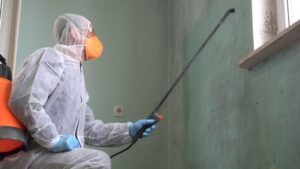Mold Removal is a comprehensive process that includes assessment, inspection, cleaning, and disinfection of contaminated materials. It also entails dehumidification and air quality testing.

Cleaning solutions used in Mold Remediation include white vinegar, bleach, and hydrogen peroxide. It is a good idea to use rubber gloves, eye protection, and a face mask when working with these chemicals. Contact Mold Removal Salt Lake City for professional help.
Ammonia is a powerful cleaning solution that can kill mold and other types of mildew. However, it is dangerous to use if mixed with bleach, as it produces toxic fumes that are poisonous to breathe. Bleach is also only effective on surface mold growth, and it can’t penetrate porous materials like drywall. Luckily, there are several other household products that can effectively clean up and remove mildew or mold, including baking soda, hydrogen peroxide, white vinegar, tea tree oil, and fungicides.
Mold and mildew spores are naturally occurring byproducts of a moist environment. They often appear in damp areas like bathrooms, basements, or kitchens. They can also grow on surfaces such as wallpaper, fabric, or carpet if they’re water-damaged.
Getting rid of mold takes time and effort, but it can be the safest and most effective way to prevent further damage and health problems. To begin, it’s important to put on personal protective equipment (respirator, gloves, goggles, etc.) and to make sure the area is well ventilated. If possible, open windows and use fans to circulate the air.
After you’ve taken the necessary safety precautions, it’s time to get cleaning! Always remember to dilute any cleaning solutions and to follow the instructions on the label. When applying a solution, it’s important to let it sit for the recommended amount of time before using a scrub brush or sponge to remove any mold spores from the surface. After scrubbing, rinse the affected area and reapply any cleaning solution as needed. When reapplying, always use a fresh cloth or sponge to avoid cross-contamination. For tough spots, you may need to reapply a stronger cleaning solution or use a commercial fungicide product.
Fungicides
Fungicides are a valuable tool in the management of fungal diseases. They are commonly used when variety resistance is unavailable, limited, or insufficient to provide adequate disease control, such as with Fusarium head blight (FHB) of small grains. Fungicides also play an important role in managing diseases of many other crops, including vegetables and turf grasses.
These chemicals can be applied as preventative or curative agents, and have both direct and indirect modes of action. Most fungicides are systemic, and are translocated into green plant tissues by the transpiration stream or between plants. Some fungicides, such as the QoI and strobilurin compounds, are more translaminar in nature and move within leaves or between cells rather than through the transpiration stream.
Most of these chemicals are also absorbed by water, and are transported to surface waters via runoff or groundwater flow. These chemical residues are then deposited in surface water bodies where they can potentially impact aquatic organisms, including fish and humans.
Some of the most common fungicides include carbamates, dithiocarbamates, and DMIs (FRAC group 3). The majority of these chemicals are considered to be persistent, or long-lived in soil environments. Other fungicides are non-persistent and degrade rapidly in the environment, primarily through the microbial community.
The timing of snow mold fungicide applications has been shown to have a significant impact on the effectiveness of the application. Some superintendents make these applications based on calendar dates, while others adjust their schedules according to weather patterns. The results from this study indicate that a golf course superintendent’s ability to manage snow mold is directly linked to his or her ability to properly time fungicide applications.
It is also important to note that biocides, like bleach, can only treat the symptoms of mold growth and not the root cause. The best method to address a mold infestation is to remove the spores and the source of moisture, which can be done through professional remediation services.
Vinegar
Vinegar is an effective mold killer, but it’s important to use the right kind. White vinegar with acetic acid is best for combating mold growth because it penetrates porous surfaces and kills the spores that cause mold to grow. It’s also safer than bleach, which can irritate skin and eyes when used improperly.
Vinegar can be combined with other natural substances for additional mold-fighting power. Tea tree oil, for instance, contains terpinen-4-ol, which was found to be more effective than vinegar and two types of commercial mold cleaners in one 2015 study. Simply add 10 to 30 drops of the oil into a spray bottle filled with vinegar, and apply the solution to the moldy area.
Make sure to wear gloves, eye protection and a mask when using vinegar to avoid contact with mold spores. Ideally, work in a well-ventilated room and open windows to promote air circulation during the cleaning process. This will help disperse the strong odor of the vinegar and prevent it from overpowering your home.
After applying the vinegar solution to the moldy surface, leave it alone for an hour to give it time to penetrate the spores and kill them. If scrubbing is necessary, apply a solution made of baking soda and water to the area first. Be sure not to mix vinegar with bleach or hydrogen peroxide, as this can produce toxic chlorine gas. After scrubbing, rinse the area with clean water and allow it to dry completely. Avoid the temptation to dry the surface with a fan or dehumidifier, as this can trap moisture and lead to further mold growth.
Bleach
When a homeowner discovers mold due to a roof leak, bathroom moisture, or even a flood, it is only natural for them to want to use something like bleach in order to kill the mold and make their home safe again. However, there are much better and safer ways to clean up the mold outbreak that will also kill it and ensure that it never returns.
Bleach is most effective against mold when used on non-porous surfaces such as porcelain tiles or metal. It can be helpful when used in combination with other cleaning products such as detergents or abrasives. Porous surfaces may require alternative cleaning methods or longer treatment times to effectively eradicate the mold, depending on the type of surface and how extensive the infestation is. For instance, black mold (Stachybotrys chartarum) is a particularly difficult type of mold to kill with conventional bleach treatments, as it has a unique protective outer layer and can penetrate deep into the material where it lives.
Additionally, using bleach on a porous surface can actually encourage further growth. As the bleach evaporates, it leaves behind moisture which is what mold needs to thrive. This moisture seeps into porous materials and can weaken wood fibers, discolor fabrics, corrode metal, and cause the harmful mold spores to spread throughout your home. In addition, bleach produces toxic vapors that pollute the air, making it hazardous to both people and pets. Bleach also creates a byproduct known as dioxin which has been linked to cancer. For these reasons, it is best to avoid using chlorine bleach for any purpose, especially when tackling a mold remediation project in your home.
Water
Mold is a toxic substance that can cause health problems for the people living in your house. It can also lead to severe structural damage. Hence, it is important to hire a professional mold remediation service to handle the problem. The professionals will use a variety of chemicals to kill the mold and other fungi. Moreover, they will take preventive measures to stop the spread of mold in the future. Some of these precautionary measures include spreading polyethene around the affected area, using filters to absorb the moisture and spraying the mold with fungicide. Besides, they will make sure to fix any leaks in your property immediately.
It is essential to clean and dry your home within 24 to 48 hours after a flood or other water damage. During this time, it is important to open windows and doors so that the air can circulate. You can also use fans to help dehumidify the house. When cleaning, remember to wear non-porous gloves and avoid mixing chlorine bleach solution with other cleaners or detergents. This will produce toxic fumes that can cause respiratory irritation.
The best way to prevent mold is to keep humidity levels low in your house. The ideal humidity in your home should be between 40 and 50 °F. You can reduce the humidity in your house by putting vents in bathrooms and kitchens, sealing attics and crawl spaces, insulating cold spots, and sloping ground to drain away moisture.
If you find mold in your house, it is important to treat the problem as soon as possible. Mold can eat through most materials and cause serious structural damage. It can also produce irritants and allergens that can cause health effects. In addition, mold can create a musty odor in your home. Depending on the extent of the infestation, you may need to move out of your home until the mold is removed.



